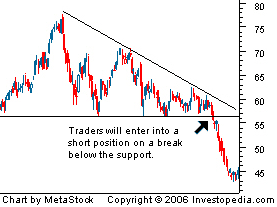Descending Triangle
A bearish chart pattern used in technical analysis that is created by drawing one trendline that connects a series of lower highs and a second trendline that has historically proven to be a strong level of support. Traders watch for a move below support, as it suggests that downward momentum is building. Once the breakdown occurs, traders enter into short positions and aggressively push the price of the asset lower. The chart below is an example of a descending triangle:

This is a very popular tool among traders because it clearly shows that the demand for an asset is weakening, and when the price breaks below the lower support, it is a clear indication that downside momentum is likely to continue or become stronger. Descending triangles give technical traders the opportunity to make substantial profits over a brief period of time. The most common price targets are generally set to equal the entry price minus the vertical height between the two trendlines.
A descending triangle is the bearish counterpart of an ascending triangle.

This is a very popular tool among traders because it clearly shows that the demand for an asset is weakening, and when the price breaks below the lower support, it is a clear indication that downside momentum is likely to continue or become stronger. Descending triangles give technical traders the opportunity to make substantial profits over a brief period of time. The most common price targets are generally set to equal the entry price minus the vertical height between the two trendlines.
A descending triangle is the bearish counterpart of an ascending triangle.
附件列表
词条内容仅供参考,如果您需要解决具体问题
(尤其在法律、医学等领域),建议您咨询相关领域专业人士。
如果您认为本词条还有待完善,请 编辑
上一篇 Descending Tops 下一篇 Disparity Index
